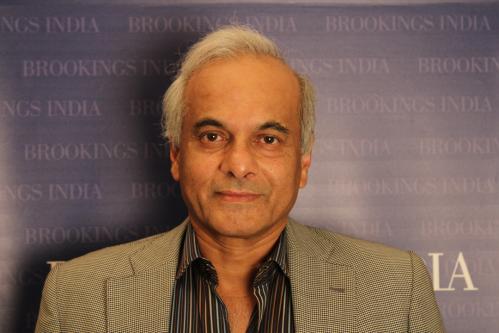Content from the Brookings Institution India Center is now archived. After seven years of an impactful partnership, as of September 11, 2020, Brookings India is now the Centre for Social and Economic Progress, an independent public policy institution based in India.
A year ago, I was requested to make recommendations on a 100-day action plan on energy for the new government. In response, I offered the following suggestions, which I hoped might define the roadmap for the following year.
Steps should be taken to institutionalise the formulation of an integrated energy policy. The roadblocks constraining the production of oil, gas and coal should be removed; prices should be aligned to the market and the distortionary implications of subsidies should be addressed; competition should be reinvigorated by levelling the playing field between the public and private sectors; tax administration should be simplified and the anomalies of a cascading tax structure corrected by bringing petroleum within the ambit of the GST; the public-private partnership model should be reconfigured to attract private capital into gas pipelines, power transmission and distribution systems, railways and other essential logistic infrastructure; and finally, the PM should place his weight behind the transition towards a low-carbon growth path. I stressed that given the capital and technology intensive nature of energy and the fact that it is subject to inherently volatile geopolitics, the policy should be seen through lenses that enable medium- to long-term reflection and flexibility.
A year on, I ask, has the government moved along the suggested pathway? What has the government achieved, and where are the shortfalls? On balance, in my view, the results are impressive.
The most notable positive has been the decision to roll together the ministries of power, coal and renewables under the charge of one minister. Earlier, it was handled by three separate cabinet ministers. The decision is notable not so much because it has had much of an impact but because it confirms that the PM wants energy policy to be viewed through an integrated prism. Ideally, the PM should have created a supra “ministry of energy” that included petroleum with a senior cabinet appointee and several ministers of state (and respective secretaries), a la the ministries of finance, defence and external affairs. This would have reinforced the integrationist trend and in particular perforated the vertically structured conduit that currently directs the movement of files and the formalities of official interaction. But that would have been a stretch too far and to not welcome a good first step simply because it falls short of the best would be churlish, to say the least.
A second positive has been the unclogging of the coal industry. It remains to be seen whether the companies that have secured coal mining leases will be able to raise the finance or offload their output on remunerative terms. Many of them are highly leveraged; some will face huge transportation costs, and given that coal is a tradable, all will be price-constrained by the competitive pressures of imports. This said, there is no denying that the ministry of coal has breathed fresh life into the sector. Coal production has, in the first month of the 2015-16 financial year, posted a double-digit growth rate.
A third positive is the rationalisation of prices and reduction in subsidies. The government did no doubt receive a major fillip from the collapse in oil prices. However, it leveraged this bonanza well and deregulated the prices of transportation fuels and implemented the direct benefit transfer (DBT) scheme. Today, the prices of diesel and petrol are aligned to the market and the cash drain on the exchequer on account of petroleum subsidies has dropped from Rs 96,800 crore in 2012-13 to a budgeted Rs 30,000 crore for 2015-16. The DBT scheme has further enabled the government to weed out “benami” beneficiaries. It is reported there are 150 million LPG connections. Of these, only 126 million have actually enrolled for the DBT. The rest (20-30 million) must be ghost entries, duplicate connections and voluntary opt-outs.
A final positive is the push given to clean energy. The PM called for a “saffron [solar] revolution” a month into his new role and since then, the government has jacked up its target for solar and wind energy. It is now committed to increasing solar energy capacity from the current 2.5 gigawatt (GW) to over 100 GW by 2022, and wind energy from the current 26 GW to 50 GW by 2030. These are ambitious targets. Until now, the government has added, on average, 1-1.5 GW of renewable energy per annum (mostly wind). Now it is pushing to add 19 GW of solar and 6 GW of wind annually.
And that too in the face of an inadequate grid that will have difficulty absorbing such a massive influx of intermittent and variable electrons, and an estimated investment requirement of $100 billion plus.
The targets are prima facie unattainable, but I am positive because it confirms that clean energy is high on the government’s policy agenda.
But the record is not without blemish. One is still waiting to see the contours of the New Exploration Licensing Policy. Oil and gas production has not picked up; the exploration intensity of our sedimentary basins is still amongst the lowest in the world and there is lack of clarity on fiscal, pricing, operational and regulatory issues, which have stalled the conversion of discoveries into actual production.
Judging from what one reads, I get the sense that bureaucrats in the ministry of petroleum are still reluctant to take decisions because of the “Reliance factor”. I use the latter phrase to reflect official reluctance to take decisions involving the private sector that might, at some later date, attract the attention of the CBI/ CVC/ CAG. A second concern surrounds the clashing objectives of trebling coal production on the one hand and controlling air pollution on the other. The latter is now of “deathly” importance and yet there is scant discussion on issues like carbon taxes, enforcement of emission standards and decarbonisation technology. In the run-up to the Paris climate change summit, the government must prepare a blueprint on how it plans to solve this conundrum.








Commentary
Op-edA new energy
THE INDIAN EXPRESS
May 4, 2015